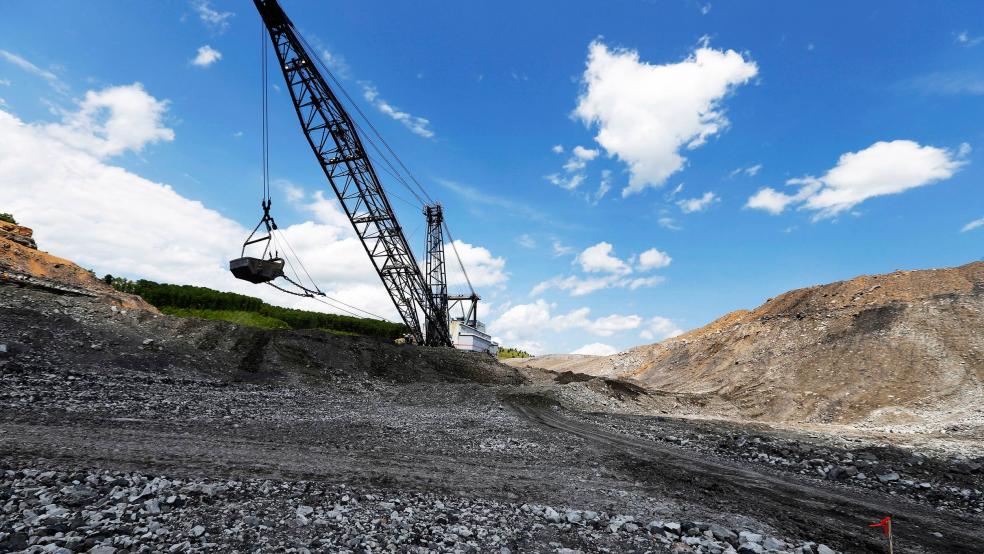U.S. coal exports are rising this year, giving the fossil-fuel friendly Trump administration reason to cheer, but analysts believe the good times won't last.
The surge in exports doesn't herald a reversal of coal's fortunes, but a temporary blip to be expected every few years, according to experts. The latest spike is due to a temporary rise in coal prices that is opening a window of opportunity for miners.
Related: U.S. coal exports soar, in boost to Trump energy agenda, data shows
Coal exports were up 58 percent in the first quarter from the same period last year, but analysts say the long-term trend is down.
"I don't think 2017 will be a typical year, but it might be a typical every fourth or fifth year. We'll get these strong years and we'll get these years of lower exports in between," said James Stevenson, senior director of IHS Markit's global coal practice.
The U.S. Energy Information Administration forecasts growth in coal exports will moderate in the coming months. Total exports are on pace to rise about 20 percent this year from 2016.
The lumpy nature of U.S. coal exports illustrates the challenge President Donald Trump faces in delivering one of his core campaign promises: reviving an ailing coal industry and putting miners back to work. As cheap natural gas and policies that favor renewable energy erode coal's share of U.S. electricity generation, the White House has looked overseas for growth opportunities.
Related: Trump seeks to ax Appalachia economic programs, causing worry in coal country
The Trump administration recently helped broker a deal to ship700,000 tons of thermal coal from mines owned by Pennsylvania-based Xcoal Energy to Ukrainian state-owned power generator Centrenergo PJSC. Ukraine cannot access much of its domestic supply because of an ongoing conflict with rebels who control its coal-producing region.
To be sure, the United States is a dominant exporter of metallurgical coal — the type used in industrial processes like steelmaking — but it plays a much smaller role in trading thermal coal, which supplies power plants.
Thermal coal accounts for most of the current spike. It surged from about 4 million short tons in the first quarter of 2016 to more than 10 million short tons in the first three months of this year.
The international market for thermal coal is split down the globe. Australia and Indonesia dominate trade in the Pacific basin, where China, India, Japan and South Korea are the biggest buyers. Colombia and South Africa outmatch the United States in the Atlantic basin, which includes the European, African, Latin American and Middle Eastern markets.
Straddling Asia and Europe, Russia exported about four times as much thermal coal as the United States shipped in 2014. American miners essentially mop up the remaining demand for thermal coal, though they do steady business with some foreign buyers.
But the type of export spike the U.S. coal industry is experiencing right now typically occurs when a number of market forces align. Coal prices need to be high enough and transportation rates low enough to make it worth the while to ship U.S. coal overseas.
Thermal coal prices surged 30 percent in Asia in the last three months and 19 percent in Europe in the same period, according to FactSet. China — the world's biggest coal consumer and producer — put limits on domestic mining in the last year to shrink excess capacity. A cyclone in Australia and a graft probe at a key Indonesian port further disrupted supplies this year, helping to keep the coal price rally alive.
Related: Trump declares end to 'war on coal,' but utilities aren't listening
On the demand side, France has experienced widespread shutdowns at nuclear power plants, boosting Western Europe's appetite for coal.
U.S.-based thermal coal producers Arch Coal and Cloud Peak Energyrecently told analysts that overseas demand and pricing are supporting continued exports in the second half of the year. Arch Coal said it would run Colorado and West Virginia mines at higher production rates in part due to strong foreign demand, helping to improve the company's cost performance.
But export spikes caused by temporary disruptions do not give producers the certainty they need to open new mines and significantly expand their payrolls, said Stevenson.
"They need a 12-month or 18-month purchase agreement before they commit capital," he said. "They won't spend capital to increase production in the hopes of selling tons. If they feel like there's a shortage that's going to last long enough, they may do it."
In the long-term, U.S. exports face multiple challenges. China is scaling back plans for new coal-fired power plants. India aims to produce more of the coal it consumes. South Korea's new president has plans to ween the country off coal.
"The risk around how much of the U.S. coal is going to make it into the international market is there are going to be a lot of uncertainties," said Mohammed Hamdaoui, product director at energy research firm Wood Mackenzie.
Xcoal, the private company that won the contract to supply Ukraine, does not comment on foreign transactions, but spokesman Ted O'Brien told CNBC he believes U.S. miners are ideally positioned to supply the Atlantic basin. He believes the Ukraine deal will open more trade opportunities elsewhere in Europe by giving U.S. miners an opportunity to prove they are dependable partners.
"When you look at the U.S. and compare us to other major coal suppliers, our infrastructure is much more reliable and proven, and we're much less prone to natural disasters that result in temporary catastrophic disruptions to supply," he said.
This article originally appeared on CNBC. Read more from CNBC:
Trump abruptly ends manufacturing council after CEOs disband strategy and policy forum
Top GOP tax writer says Congress is focused on tax reform despite Charlottesville tension

